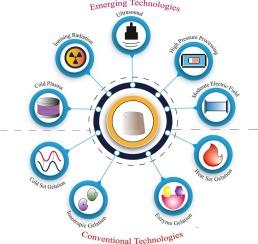利用新兴技术制造水凝胶:来源、机制和食品应用
IF 6.8
1区 农林科学
Q1 FOOD SCIENCE & TECHNOLOGY
Innovative Food Science & Emerging Technologies
Pub Date : 2025-09-10
DOI:10.1016/j.ifset.2025.104226
引用次数: 0
摘要
水凝胶是分散在水性基质中的交联聚合物链的三维网络,由于其高保水能力和可调节的功能特性,广泛应用于食品,生物医学和制药行业。传统的水凝胶制造方法依赖于热、离子和酶,并且被广泛使用,但经常受到诸如高能量需求和对凝胶结构的有限控制等限制。近年来,非热技术作为传统水凝胶制造方法的有前途的替代品而受到关注。这些新技术,包括高压加工、超声波、冷等离子体、中等电场和电离辐射,提供了显著的优势,如增强结构完整性、缩短加工时间和提高能源效率。每种技术都通过不同的物理化学机制来影响聚合物的相互作用、交联密度和致密的凝胶网络。这篇综述提供了水凝胶来源和不同的制造方法的全面概述,然后详细比较了传统和新兴的加工技术。重点放在新技术的机理见解及其对水凝胶关键性质的影响,包括机械强度、膨胀行为、孔隙度和稳定性。在食品工业中,水凝胶具有多种功能,如质地调节剂、脂肪替代品、营养保健品的输送系统、智能包装材料和生物传感平台。新兴技术定制水凝胶特性的能力为下一代功能性食品系统的发展提供了巨大的潜力。然而,这些新兴技术在水凝胶制造中的实施面临着一些限制,包括初始资本投资、对技术熟练人员的要求以及与大规模工业可扩展性相关的挑战。本文章由计算机程序翻译,如有差异,请以英文原文为准。

Hydrogel fabrication using emerging technologies: Sources, mechanisms, and food applications
Hydrogels are three-dimensional networks of crosslinked polymer chains dispersed within an aqueous matrix, extensively employed in the food, biomedical, and pharmaceutical industries due to their high water-holding capacity and tunable functional properties. Conventional hydrogel fabrication methods rely on heat, ions, and enzymes, and are widely used but often suffer from limitations such as high energy requirements and limited control over the gel structure. In recent years, non-thermal technologies have gained attention as promising alternatives to conventional methods in hydrogel fabrication. These novel techniques, including high-pressure processing, ultrasound, cold plasma, moderate electric field, and ionizing radiation, offer significant advantages such as enhanced structural integrity, reduced processing time, and improved energy efficiency. Each technology operates through distinct physicochemical mechanisms that influence polymer interactions, crosslinking density, and the resulting compact gel network. This review provides a comprehensive overview of hydrogel sources and different fabrication methods, followed by a detailed comparison of conventional and emerging processing techniques. Emphasis is placed on the mechanistic insights of novel technologies and their influence on key hydrogel properties, including mechanical strength, swelling behaviour, porosity, and stability. In the food industry, hydrogels fulfil multifunctional roles as texture modifiers, fat replacers, delivery systems for nutraceuticals, smart packaging materials, and biosensing platforms. The ability of emerging technologies to tailor hydrogel characteristics holds great potential for the development of next-generation functional food systems. However, the implementation of these emerging technologies in hydrogel fabrication faces several limitations, including initial capital investment, the requirement for technically skilled personnel, and challenges associated with large-scale industrial scalability.
求助全文
通过发布文献求助,成功后即可免费获取论文全文。
去求助
来源期刊
CiteScore
12.00
自引率
6.10%
发文量
259
审稿时长
25 days
期刊介绍:
Innovative Food Science and Emerging Technologies (IFSET) aims to provide the highest quality original contributions and few, mainly upon invitation, reviews on and highly innovative developments in food science and emerging food process technologies. The significance of the results either for the science community or for industrial R&D groups must be specified. Papers submitted must be of highest scientific quality and only those advancing current scientific knowledge and understanding or with technical relevance will be considered.

 求助内容:
求助内容: 应助结果提醒方式:
应助结果提醒方式:


